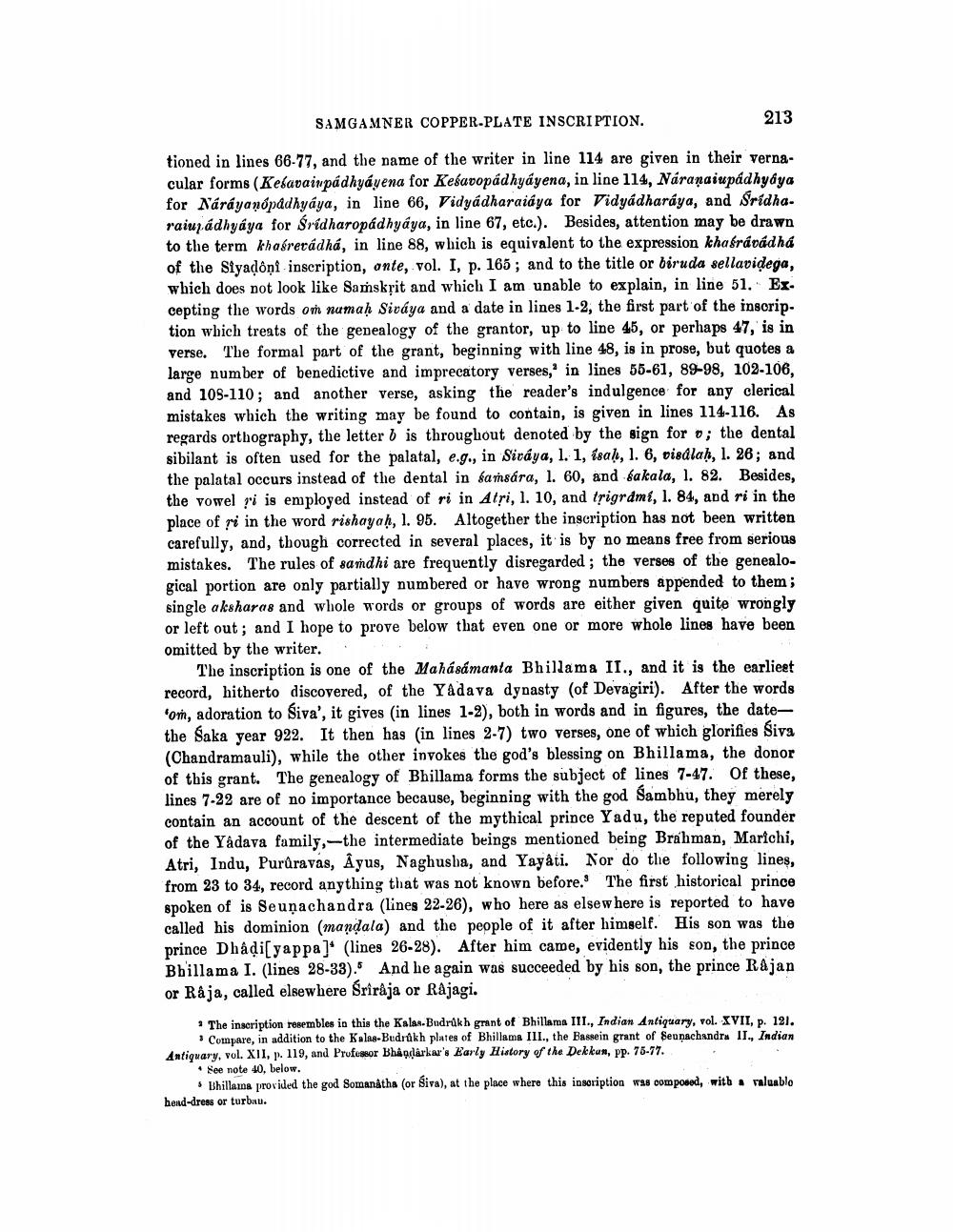________________
SAMGAMNER COPPER-PLATE INSCRIPTION.
213
tioned in lines 66-77, and the name of the writer in line 114 are given in their vernacular forms (Kelavainpadhyayena for Kebadopadhyayena, in line 114, Naranaiupadhyaya for Náráyanopadhyaya, in line 66, Vidyadharaidya for Vidyadharaya, and Sridha. raiupadhyaya for Sridharopádhyaya, in line 67, etc.). Besides, attention may be drawn to the term khasrerådhá, in line 88, which is equivalent to the expression khabrávádhá of the Siyadoņi inscription, ante, vol. I, p. 165; and to the title or biruda sellavidega, which does not look like Samskrit and which I am unable to explain, in line 51. Ex. cepting the words om namah Sivaya and a date in lines 1-2, the first part of the inscription which treats of the genealogy of the grantor, up to line 45, or perhaps 47, is in verse. The formal part of the grant, beginning with line 48, is in prose, but quotes a large number of benedictive and imprecatory verses,' in lines 55-61, 89-98, 102-106, and 105-110; and another verse, asking the reader's indulgence for any clerical mistakes which the writing may be found to contain, is given in lines 114-116. As regards orthography, the letter b is throughout denoted by the sign for o; the dental sibilant is often used for the palatal, e.g., in Siráya, l. 1, isal, 1. 6, visdlah, I. 26; and the palatal occurs instead of the dental in samsára, 1. 60, and sakala, l. 82. Besides, the vowel ?i is employed instead of ri in Atri, 1. 10, and trigrami, 1. 84, and ri in the place of ri in the word rishayaḥ, 1. 95. Altogether the inscription has not been written carefully, and, though corrected in several places, it is by no means free from serious mistakes. The rules of samdhi are frequently disregarded; the verses of the genealogical portion are only partially numbered or have wrong numbers appended to them; single aksharas and whole words or groups of words are either given quite wrongly or left out, and I hope to prove below that even one or more whole lines have been omitted by the writer. .
The inscription is one of the Mahásámanta Bhillama II., and it is the earliest record, hitherto discovered, of the Yadava dynasty (of Devagiri). After the words
om, adoration to Siva', it gives (in lines 1-2), both in words and in figures, the datethe Saka year 922. It then has (in lines 2-7) two verses, one of wbich glorifies Siva (Chandramauli), while the other invokes the god's blessing on Bhillama, the donor of this grant. The genealogy of Bhillama forms the subject of lines 7-47. Of these, lines 7-22 are of no importance because, beginning with the god Sambhu, they merely contain an account of the descent of the mythical prince Yadu, the reputed founder of the Yadava family,--the intermediate beings mentioned being Brahman, Marichi, Atri, Indu, Purůravas, Ayus, Naghusha, and Yayati. Nor do the following lines, from 23 to 34, record anything that was not known before. The first historical prince spoken of is Seuņachandra (lines 22-26), who here as elsewhere is reported to have called his dominion (mandala) and the people of it after himself. His son was the prince Dhadisyappa]* (lines 26-28). After him came, evidently his son, the prince Bhillama I. (lines 28-33). And he again was succeeded by his son, the prince Rajan or Raja, called elsewhere Sriraja or Rajagi.
· The inscription resembles in this the Kalas.Budrukh grant of Bhillama III., Indian Antiquary, vol. XVII, p. 121.
Compare, in addition to the Kalas-Budrukh plates of Bhillama III., the Bassein grant of Seunachandra II., Indian Antiquary, vol. XII, p. 119, and Professor Bhaqdärkar's Early History of the Dekkun, pp76-77.
• See note 40, below.
Bhillans provided the god somanatha (or Siva), at the place where this inscription was composed, with valuable head-dress or turbau.




